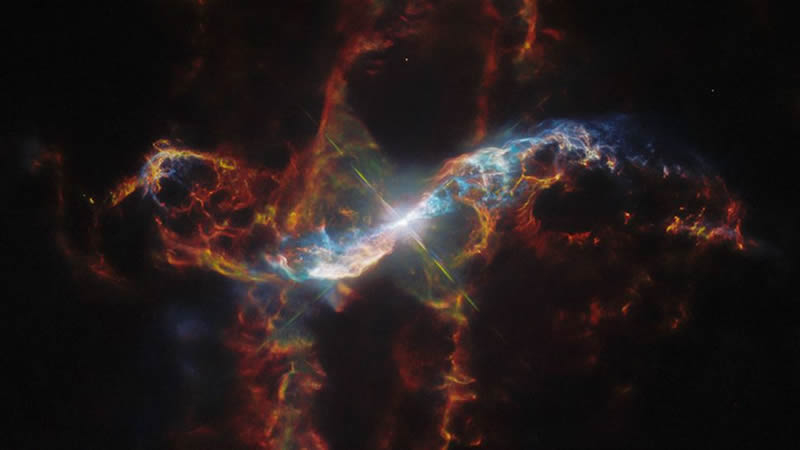The Hubble Space Telescope has captured dramatic, colorful close-ups of two nearby stars in the constellation Aquarius that have been in close contact for centuries. The space observatory demonstrated the complex interaction of the stellar duo.

Image source: Hubble (NASA)
The new image shows a spectacular hourglass-shaped nebula formed by the centuries-long interaction of two stars: a compact, largely unchanged white dwarf (a hot burned-out star) and its companion star, a cool red giant that has grown to a size larger than our Sun more than 400 times, and changing its temperature and brightness 750 times over a period of approximately 390 Earth days.
This star system, known as R Aquarii (R Aquarii), is located about 710 light years from Earth in the constellation Aquarius. It belongs to the symbiotic class of variable stars, which, by analogy with the biological term “symbiosis,” means the coexistence of two different objects – completely different types of stars – in close proximity to each other.
The white dwarf, orbiting the red giant with an orbital period of 44 years, drops matter onto its surface as it approaches, exploding from time to time like a “giant hydrogen bomb.” The explosion sends twisted streams of glowing gas into space that scientists describe as looking like “a garden sprinkler gone crazy.” The ejected material rushes into space at speeds of more than 1.6 million kilometers per hour. As an example, scientists give the distance from the Earth to the Moon, which is covered in 15 minutes!
The process clearly demonstrates how the Universe redistributes the products of thermonuclear fusion, which are formed deep inside stars and ejected back into space. And some of these products include heavier elements such as carbon, nitrogen and oxygen, which are the most important building blocks of planets like ours.
As one of the closest symbiotic stars, R Aquarii has been extensively studied using a variety of space and ground-based telescopes. For example, the Hubble telescope began observing it shortly after its launch into orbit in 1990. A decade later, the Chandra X-ray Observatory began tracking changes in the nebula’s X-ray emissions, mainly emitted by its knotty jet and the shock waves that R Aquarii generates when it collides with surrounding matter. Based on these observations, astronomers suggest that the white dwarf last erupted in the late 1970s, and the next explosion may not occur until 2470 at the earliest.
Hubble’s latest image of the star system shows that, as a result of powerful magnetic fields and the force of the explosion itself, the ejected material formed a spiral pattern and spread over a distance of more than 400 billion kilometers, which is 24 times the diameter of our solar system, and across According to the Hubble team, it is “truly incredible, even by astronomical standards.” Time-lapse images of R Aquarii taken over the past 10 years show changes in the pair’s brightness caused by the red giant’s violent pulsations, as well as the dramatic evolution of the surrounding nebula.